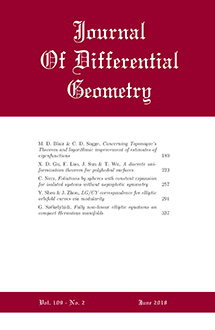Abstract
We prove two types of nodal results for density $1$ subsequences of an orthonormal basis $\{ \phi_j \}$ of eigenfunctions of the Laplacian on a negatively curved compact surface $(M,g)$. The first result pertains to Riemann surfaces $(M, J, \sigma)$ with an anti-holomorphic involution $\sigma$ such that $M - \mathrm{Fix}(\sigma)$ has more than one component. In any genus $\mathfrak{g}$, there is a $(3\mathfrak{g} - 3)$-dimensional moduli space of such real Riemann surfaces. Our main result is that, for any negatively curved $\sigma$-invariant metric $\mathfrak{g}$ on $M$, the number of nodal domains of the even or odd $\Delta_{\mathfrak{g}}$-eigenfunctions tends to infinity along a density $1$ subsequence. For a generic $\sigma$-invariant negatively curved metric $\mathfrak{g}$, the multiplicity of all eigenvalues equals $1$, and all eigenfunctions are either even or odd, and therefore the result holds for almost any eigenfunction.
The analytical part of the proof shows that the number of zeros of even eigenfunctions restricted to $\mathrm{Fix}(\sigma)$, and the number of singular points of odd eigenfunctions on $\mathrm{Fix}(\sigma)$, tend to infinity. This is a quantum ergodic restriction phenomenon. Our second result generalizes this statement to any negatively curved surface $(M,g)$ and to a generic curve $C \subset M$: the number of zeros of eigenfunctions $\phi_j |_C$ tends to infinity.
The additional step to obtain a growing number of nodal domains in the $(M, J, \sigma)$ setting is topological. It generalizes an argument of Ghosh, Reznikov, and Sarnak on the modular domain to higher genus.
Citation
Junehyuk Jung. Steve Zelditch. "Number of nodal domains and singular points of eigenfunctions of negatively curved surfaces with an isometric involution." J. Differential Geom. 102 (1) 37 - 66, January 2016. https://doi.org/10.4310/jdg/1452002877
Information





